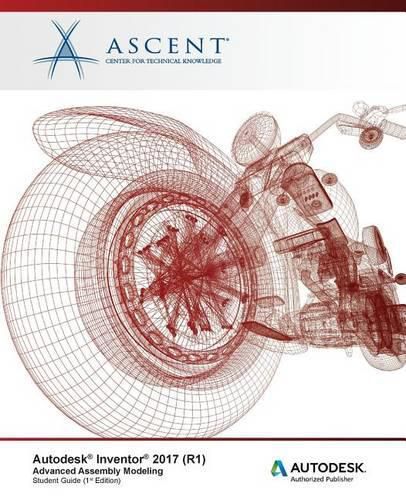Readings Newsletter
Become a Readings Member to make your shopping experience even easier.
Sign in or sign up for free!
You’re not far away from qualifying for FREE standard shipping within Australia
You’ve qualified for FREE standard shipping within Australia
The cart is loading…






The Autodesk® Inventor® 2017 (R1) Advanced Assembly Modeling student guide builds on the skills acquired in the Autodesk® Inventor® 2017 (R1) Introduction to Solid Modeling and Autodesk® Inventor® 2017 (R1) Advanced Part Modeling student guides to take students to a higher level of productivity when creating and working with assemblies.
You begin by focusing on the Top-Down Design workflow. You learn how tools are used to achieve this workflow using Derive, Multi-Body Design, and Layouts. Other topics include model simplification tools, Positional and Level of Detail Representations, iMates and iAssemblies, Frame Generator, Design Accelerator, and file management and duplication techniques. A chapter has also been included about the Autodesk® Inventor® Studio to teach you how to render, produce, and animate realistic images.
Topics Covered
Applying motion to existing assembly constraints using Motion and Transitional Constraints. Introduction of the Top-Down Design technique for creating assemblies and its components. Tools for Top-Down Design, such as associative links, adaptive parts, multi-body and layout design, derived components, and skeleton models. Creating Positional Representations to review motion, evaluate the position of assembly components, or document an assembly in a drawing. Using Shrinkwrap and other model simplification tools to create a part model that represents an overall assembly. Creating Level of Detail Representations to reduce the clutter of large assemblies, reduce retrieval times, and substituting models. Using the Design Accelerator to easily insert standard and customizable components and features into your model. Creating rendered realistic images and animations of parts and assemblies using Autodesk Inventor Studio and the Video Producer. Using iMates and iAssemblies to work efficiently with assemblies. Using the Frame Generator to create structural members. Using pattern, mirror, and copy techniques to duplicate components in an assembly. Working with weldments. Link and drive parameters to and from a spreadsheet. You also learn to custom format and create expressions in a parameter.
Prerequisites The class assumes mastery of Autodesk Inventor basics as taught in Autodesk Inventor Introduction to Solid Modeling. Autodesk Inventor Advanced Part Modeling knowledge is recommended. The use of Microsoft Excel is required for this training course.
$9.00 standard shipping within Australia
FREE standard shipping within Australia for orders over $100.00
Express & International shipping calculated at checkout
Stock availability can be subject to change without notice. We recommend calling the shop or contacting our online team to check availability of low stock items. Please see our Shopping Online page for more details.
The Autodesk® Inventor® 2017 (R1) Advanced Assembly Modeling student guide builds on the skills acquired in the Autodesk® Inventor® 2017 (R1) Introduction to Solid Modeling and Autodesk® Inventor® 2017 (R1) Advanced Part Modeling student guides to take students to a higher level of productivity when creating and working with assemblies.
You begin by focusing on the Top-Down Design workflow. You learn how tools are used to achieve this workflow using Derive, Multi-Body Design, and Layouts. Other topics include model simplification tools, Positional and Level of Detail Representations, iMates and iAssemblies, Frame Generator, Design Accelerator, and file management and duplication techniques. A chapter has also been included about the Autodesk® Inventor® Studio to teach you how to render, produce, and animate realistic images.
Topics Covered
Applying motion to existing assembly constraints using Motion and Transitional Constraints. Introduction of the Top-Down Design technique for creating assemblies and its components. Tools for Top-Down Design, such as associative links, adaptive parts, multi-body and layout design, derived components, and skeleton models. Creating Positional Representations to review motion, evaluate the position of assembly components, or document an assembly in a drawing. Using Shrinkwrap and other model simplification tools to create a part model that represents an overall assembly. Creating Level of Detail Representations to reduce the clutter of large assemblies, reduce retrieval times, and substituting models. Using the Design Accelerator to easily insert standard and customizable components and features into your model. Creating rendered realistic images and animations of parts and assemblies using Autodesk Inventor Studio and the Video Producer. Using iMates and iAssemblies to work efficiently with assemblies. Using the Frame Generator to create structural members. Using pattern, mirror, and copy techniques to duplicate components in an assembly. Working with weldments. Link and drive parameters to and from a spreadsheet. You also learn to custom format and create expressions in a parameter.
Prerequisites The class assumes mastery of Autodesk Inventor basics as taught in Autodesk Inventor Introduction to Solid Modeling. Autodesk Inventor Advanced Part Modeling knowledge is recommended. The use of Microsoft Excel is required for this training course.